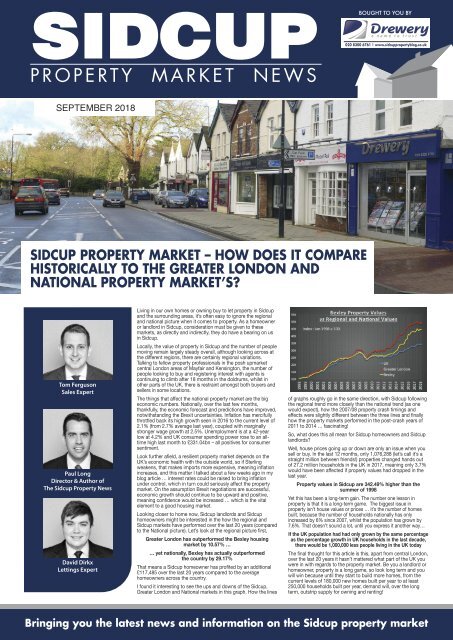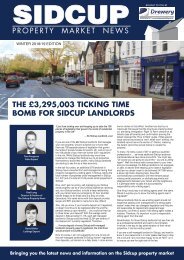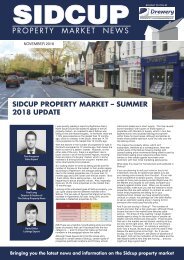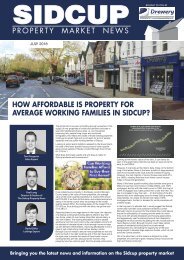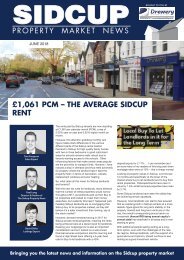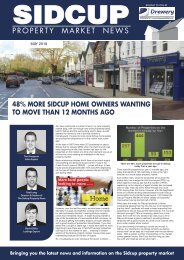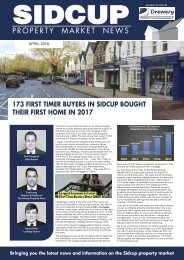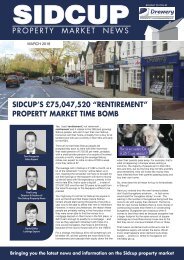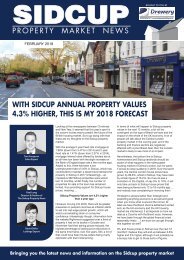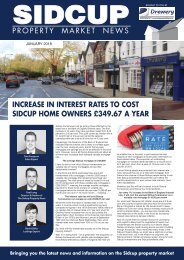SIDCUP PROPERTY NEWS - SEPTEMBER 2018
Drewery Property Consultants Keeping you informed of current trends in the property market and industry related articles.
Drewery Property Consultants Keeping you informed of current trends in the property market and industry related articles.
Create successful ePaper yourself
Turn your PDF publications into a flip-book with our unique Google optimized e-Paper software.
<strong>SIDCUP</strong><br />
P R O P E R T Y M A R K E T N E W S<br />
BOUGHT TO YOU BY<br />
020 8300 6761 | www.sidcuppropertyblog.co.uk<br />
<strong>SEPTEMBER</strong> <strong>2018</strong><br />
<strong>SIDCUP</strong> <strong>PROPERTY</strong> MARKET – HOW DOES IT COMPARE<br />
HISTORICALLY TO THE GREATER LONDON AND<br />
NATIONAL <strong>PROPERTY</strong> MARKET’S?<br />
Tom Ferguson<br />
Sales Expert<br />
Paul Long<br />
Director & Author of<br />
The Sidcup Property News<br />
David Dirkx<br />
Lettings Expert<br />
Living in our own homes or owning buy to let property in Sidcup<br />
and the surrounding areas, it’s often easy to ignore the regional<br />
and national picture when it comes to property. As a homeowner<br />
or landlord in Sidcup, consideration must be given to these<br />
markets, as directly and indirectly, they do have a bearing on us<br />
in Sidcup.<br />
Locally, the value of property in Sidcup and the number of people<br />
moving remain largely steady overall, although looking across at<br />
the different regions, there are certainly regional variations.<br />
Talking to fellow property professionals in the posh upmarket<br />
central London areas of Mayfair and Kensington, the number of<br />
people looking to buy and registering interest with agents is<br />
continuing to climb after 18 months in the doldrums, whilst in<br />
other parts of the UK, there is restraint amongst both buyers and<br />
sellers in some locations.<br />
The things that affect the national property market are the big<br />
economic numbers. Nationally, over the last few months,<br />
thankfully, the economic forecast and predictions have improved,<br />
notwithstanding the Brexit uncertainties. Inflation has mercifully<br />
throttled back its high growth seen in 2016 to the current level of<br />
2.1% (from 2.7% average last year), coupled with marginally<br />
stronger wage growth at 2.5%. Unemployment is at a 42-year<br />
low at 4.2% and UK consumer spending power rose to an alltime<br />
high last month to £331.04bn – all positives for consumer<br />
sentiment.<br />
Look further afield, a resilient property market depends on the<br />
UK’s economic health with the outside world, so if Sterling<br />
weakens, that makes imports more expensive, meaning inflation<br />
increases, and this matter I talked about a few weeks ago in my<br />
blog article … interest rates could be raised to bring inflation<br />
under control, which in turn could seriously affect the property<br />
market. On the assumption Brexit negotiations are successful,<br />
economic growth should continue to be upward and positive,<br />
meaning confidence would be increased … which is the vital<br />
element to a good housing market.<br />
Looking closer to home now, Sidcup landlords and Sidcup<br />
homeowners might be interested in the how the regional and<br />
Sidcup markets have performed over the last 20 years (compared<br />
to the National picture). Let’s look at the regional picture first,<br />
Greater London has outperformed the Bexley housing<br />
market by 10.57% …<br />
… yet nationally, Bexley has actually outperformed<br />
the country by 29.17%<br />
That means a Sidcup homeowner has profited by an additional<br />
£117,485 over the last 20 years compared to the average<br />
homeowners across the country.<br />
I found it interesting to see the ups and downs of the Sidcup,<br />
Greater London and National markets in this graph. How the lines<br />
of graphs roughly go in the same direction, with Sidcup following<br />
the regional trend more closely than the national trend (as one<br />
would expect), how the 2007/08 property crash timings and<br />
effects were slightly different between the three lines and finally<br />
how the property markets performed in the post-crash years of<br />
2011 to 2014 … fascinating!<br />
So, what does this all mean for Sidcup homeowners and Sidcup<br />
landlords?<br />
Well, house prices going up or down are only an issue when you<br />
sell or buy. In the last 12 months, only 1,076,288 (let’s call it’s a<br />
straight million between friends!) properties changed hands out<br />
of 27.2 million households in the UK in 2017, meaning only 3.7%<br />
would have been affected if property values had dropped in the<br />
last year.<br />
Property values in Sidcup are 342.49% higher than the<br />
summer of 1998<br />
Yet this has been a long-term gain. The number one lesson in<br />
property is that it is a long-term game. The biggest issue in<br />
property isn’t house values or prices … it’s the number of homes<br />
built, because the number of households nationally has only<br />
increased by 6% since 2007, whilst the population has grown by<br />
7.6%. That doesn’t sound a lot, until you express it another way…<br />
If the UK population had had only grown by the same percentage<br />
as the percentage growth in UK households in the last decade,<br />
there would be 1,000,000 less people living in the UK today<br />
The final thought for this article is this, apart from central London,<br />
over the last 20 years it hasn’t mattered what part of the UK you<br />
were in with regards to the property market. Be you a landlord or<br />
homeowner, property is a long game, so look long term and you<br />
will win because until they start to build more homes, from the<br />
current levels of 180,000 new homes built per year to at least<br />
250,000 households built per year, demand will, over the long<br />
term, outstrip supply for owning and renting!<br />
Bringing you the latest news and information on the Sidcup property market
THE <strong>SIDCUP</strong> BANK OF MUM AND DAD<br />
LENT £4.07M LAST YEAR<br />
My analysis has shown that up to the end of the last quarter,<br />
Sidcup first time buyers purchased 191 Sidcup properties.<br />
With wages rising at 2.8%, unemployment at a low rate of 4.2%<br />
(down from 4.6% from a year earlier and the joint lowest since<br />
1975), national GDP rising at 1.87% and inflation at 2.3%, tied<br />
in with indifferent house price growth (compared to a few years<br />
ago), this has given first time buyers a chance to get a foot hold<br />
on the Sidcup property market.<br />
Over the last year, the average purchase price of a Sidcup first<br />
time buyer property has been £300,400 and the average<br />
deposit was £48,665. Furthermore, my calculations show the<br />
average Sidcup parents contributed £21,291 of that £48,665<br />
figure.<br />
You see “The Bank of Mum and Dad (Sidcup Branch)” is for<br />
countless Sidcup twenty something’s, perceived to be the only<br />
way they will ever be able to afford their first home. In fact,<br />
Sidcup parents put up a substantial £4.07m in the last 12<br />
months to help their nearest and dearest progeny onto the<br />
property ladder. This assistance towards the deposit makes a<br />
huge difference, enabling Sidcup youngsters who thought they<br />
couldn’t get on the housing ladder more able to do so.<br />
With mortgage rates at all-time lows, few Sidcup twenty<br />
something’s would struggle to make mortgage repayments, but<br />
it is the requirement of the deposit which is the issue, although<br />
as parents (and grandparents) are helping out where they can, it<br />
does little to address the real problems of the housing market,<br />
whether for people renting or buying their first home.<br />
If you think about it, as a Country we have been fortunate that<br />
the older generation who control the biggest share of the<br />
nation’s wealth are so plentiful to those following after. We need<br />
to remember, though, that this generosity is a sign of the issues<br />
of the British housing shortage, not its solution.<br />
But before I leave this article … note I used the word<br />
PERCEIVED in a previous paragraph. Yes, the average first time<br />
buyer deposit is 16.1%, but that is an average. Did you know<br />
95% mortgages returned to first time buyers in late 2009 and<br />
have been available ever since? Also, lenders like Barclays and<br />
many local Building Society’s now offer 100% mortgages (i.e.<br />
no deposit) at 2.75% fixed for three years.<br />
60 Second<br />
Online Property Valuation<br />
Curious to know how<br />
much your property<br />
would sell or rent for<br />
but not quite ready for a<br />
visit.<br />
Find out online instantly<br />
using our FREE online<br />
valuation tool.<br />
Sales<br />
Valuation<br />
Click here to get a<br />
FREE instant valuation<br />
visit valuation.drewery.co.uk<br />
The perception is you need 15%, 20% even a 25% deposit to<br />
be a first-time buyer – you don’t! You don’t need any deposit,<br />
but (there is always a but!)…<br />
Over the last decade, many renters have upgraded themselves<br />
into homes that they (or any generation before them) could<br />
never have ever afforded as a first time buyer in the past. You<br />
see the British housing market started to change with the dawn<br />
of the new Millennium and I am seeing a slow but steady<br />
attitude change when it comes to renting. Those tenants have<br />
found the price difference of upgrading from the typical 1970’s<br />
TV show Rigsby “Rising Damp” style rental property to plush<br />
terraced house or even semi-detached home, with all the mod<br />
cons, comparatively inexpensive (when compared to the<br />
increase in mortgage payments if they had to make the move<br />
as buyers).<br />
Renting isn’t seen as the poor man’s choice, as many young<br />
(and increasing older) people are becoming more at ease and<br />
comfortable with the flexibility offered by private renting a<br />
property rather than jumping ‘lemming like’ into home<br />
ownership. Sidcup landlords will continue to see growth in<br />
sector, and like Germany, todays renters will become<br />
homeowners in 20 years’ time – when they will inherit the<br />
wealth of their parent’s home.<br />
Current Average Asking Prices in Sidcup<br />
1<br />
BED<br />
FLAT<br />
£216,692<br />
2<br />
BED<br />
FLAT<br />
£285,212<br />
data from zoopla.co.uk using current properties being marketed<br />
2<br />
BED<br />
HOUSE<br />
£372,218<br />
3<br />
BED<br />
HOUSE<br />
£438,625<br />
4<br />
BED<br />
HOUSE<br />
£590,141<br />
For more Sidcup Property News visit: www.sidcuppropertyblog.co.uk
£400,377 – THE TYPICAL PROFIT EACH <strong>SIDCUP</strong><br />
LANDLORD COULD MAKE IN THE NEXT 25 YEARS<br />
I am of the opinion that buy to let investment in Sidcup,<br />
in the long-term, will bring substantial returns for<br />
landlords, irrespective of latest regulation and tax<br />
changes.<br />
Taking a very conservative (with a small ‘c’) view, I<br />
believe landlords will see a projected net profit of<br />
£679,757 per property over the next 25 years through<br />
capital gains and rental. When inflation is taken into<br />
account that works out at £400,377 (in today’s money) or<br />
around £16,015 per year. The breakdown applies to a<br />
basic tax-paying landlord placing a characteristic 25%<br />
deposit on a £248,600 apartment.<br />
Capital gains make up a substantial part of a landlord’s<br />
returns. Again, being conservative, I have assumed that<br />
Sidcup house prices over the next quarter century<br />
(between <strong>2018</strong> and 2043) will rise at half the rate they<br />
did between 1993 and <strong>2018</strong> (the preceding 25 years),<br />
therefore the example Sidcup property in the previous<br />
paragraph would grow in value to £775,893, providing<br />
gross capital gains of £527,293.<br />
A typical Sidcup landlord receives, on average, rent of<br />
£12,000 per annum per apartment and so, over a 25-year<br />
period, that example property would generate a total<br />
rental income of £458,700 (again – very conservatively<br />
assuming a compound annual growth rate in the rent of<br />
1.71% per annum).<br />
Nevertheless, there are costs to running a buy to let<br />
property (mortgages, void periods, repairs, agents fees<br />
etc) .. and over those same 25 years, I have estimated<br />
that to be £306,236 ... giving the net profit levels<br />
mentioned in the second paragraph.<br />
Now of course I have had to make assumptions to reach<br />
these figures, yet I hope you would agree, I have been<br />
very unadventurous with my assumptions.<br />
The Sidcup (and UK as a whole) buy to let property<br />
market is experiencing a massive sea of change.<br />
Regulation and tax changes have altered the dynamic in<br />
the property market, diminishing its appeal to<br />
inexperienced and amateur landlords, and these new tax<br />
changes mean higher tax bills for higher rate tax<br />
landlords. Yet, despite these rising costs, there are still<br />
healthy returns to be found in Sidcup buy to let<br />
investment for knowledgeable and steadfast landlords.<br />
Nonetheless, the days of anything making money and<br />
idle speculation are long gone.<br />
Buy to let is a long-term business undertaking,<br />
necessitating commitment and expertise. Don’t put your<br />
head in the sand and think it doesn’t affect you. Sidcup<br />
buy to let landlords must be equipped to start business<br />
and tax planning, take portfolio management advice to<br />
ensure their investments will meet their investment goals,<br />
appreciate the risks as well as the rewards, and, most<br />
crucially, the obligations they have towards their tenants.<br />
If you are a Sidcup landlord, irrespective of whether you<br />
are a client of mine or another agent in Sidcup (or even<br />
you do it yourself), feel free to drop me a line or pop<br />
into the office for an informal chat on the future direction<br />
of the Sidcup rental market and where opportunities<br />
may lie.<br />
Current Average Asking Rents in Sidcup<br />
1<br />
BED<br />
FLAT<br />
£947pcm<br />
2<br />
BED<br />
FLAT<br />
£1,141pcm<br />
data from zoopla.co.uk using current properties being marketed<br />
2<br />
BED<br />
HOUSE<br />
£1,181pcm<br />
3<br />
BED<br />
HOUSE<br />
£1,450pcm<br />
4<br />
BED<br />
HOUSE<br />
£1,761pcm<br />
For more Sidcup Property News visit: www.sidcuppropertyblog.co.uk


